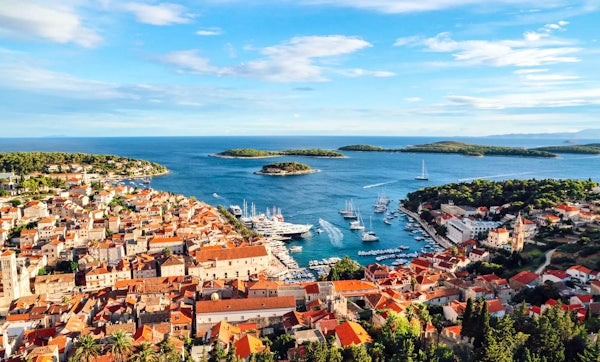Croatia Island Hopping

The Ultimate Croatia Island Hopping Guide – Everything You Need to Know!
Croatia island hopping – just a mention of the phrase is enough to raise goosebumps on the back of the neck. A bucket-list adventure on the shimmering Adriatic Sea, it's about whizzing from one deserted pebble cove to the next under the gaze of the hulking Dinaric Alps and the beating Balkan sun. Sounds good, eh?
You're darn right it's good! Raise the sail and get ready for a montage of picture-perfect lagoons haloed in slender Aleppo pines over on Mljet. Get ready to party the whole balmy night away in pumping EDM clubs on happening Hvar. Get ready to soak up the rays on the alabaster shores of the Golden Cape on Brac. And then you get the glorious runs of sand and pebble on the mainland, which can punctuate Croatia island hopping itineraries with the enthralling Roman history of Split, romantic towns on the Kvarner Gulf, or glimpses of Dubrovnik's mighty castles.
We've been doing all this for years, so we know a thing or two about calling anchors aweigh in this part of the globe. Cue this ultimate guide to Croatia island hopping, which runs through all the ins and outs of planning a sailing jaunt to this spectacular region. Ready to join us in 2026?

Best time to visit Croatia islands
Croatia island hopping in spring
Spring is a real transition time in the Adriatic Sea. The water remains pretty chilly until at least May. At least, most of the locals don't swim until then. In the air, you're looking at something like 19 degrees for daily averages in Dubrovnik, and a shade less than that up in Istria. There's actually more rain across the country as a whole in May than in March, but most of it is limited to the mountainous inland, so it's not a massive worry for sailors or island hoppers. The best part about island hopping in Croatia in the spring is the wildflowers, which bloom on Hvar and Vis and Brac from around April onwards.
Croatia island hopping in summer
An army of sails take to the seas in Croatia when the summer hits. This is the most popular time to do your island hopping and for good reason, too. The temperatures crank up to a whopping 30-40, with the southern Dalmatian coast coming in the hottest of all. You can get thunderstorms thanks to the dramatic relief of the coast, but they often look awesome when viewed from the top of a boat and usually only last an hour or so. Summer does see the biggest crowds, so it's the top time to travel if you're keen to party on the marina of Hvar or in the mega clubs of Split. The swimming is also at its peak.
Croatia island hopping in autumn
The early autumn might just be our favourite time of all to go island hopping in Croatia. There are good southerly breezes to keep the sails plump, daily highs can be 22-24 between Split and Dubrovnik, and the sea…well it's the balmiest it will be all year, as the H2O lingers at around 25 degrees into October. On top of that, school holidays start back in northern Europe, which pulls away the big crowds of family holidaymakers and leaves the beaches way less crowded than they were only one month before. These conditions are perfect for hiking on our Croatia Island Explorer, which takes full advantage of these ideal autumn conditions to showcase the very best of the Dalmatian coast.
Croatia island hopping in winter
Winter isn't the best time to hit the seas in Croatia. The water can actually be quite rough. But more to the point, thermometers can read a measly 14 degrees, which simply isn't enough to warrant cove-hopping through the Adriatic Islands. The best thing you can do in the colder months is explore the Croatian mountains and see cities like Dubrovnik and Split without the heaving crowds. Island hopping typically resumes in earnest around March or April.
How to get to Croatia
Croatia gets a whopping nine million visitors every year. With stats like that, you're sure to find loads of simple ways to arrive. You can pick from international train links that go throughout the Balkan Peninsula and beyond, long-haul buses, and an ever-growing cohort of flights with both flag-carrying and budget airlines…
While the railway lines in the Balkans leave a lot to be desired, they have come on leaps and bounds in the last couple of years. So much so, in fact, that this eco-conscious way of moving is now a viable route to the port for those looking to board a boat for island hopping in the Adriatic. There are three regular international train services to know about:
- Berlin to Zagreb (EuroCity) – A popular service that links Zagreb to the German Alps and the German capital. EuroCity (EC) trains are faster and more comfortable than their IC compadres.
- Vienna to Zagreb (InterCity) – A direct daily connection that takes 6.5 hours from the Austrian capital to the Croatian capital. You'll need an onward train within Croatia to get to the sea, though.
- Budapest to Rijeka (InterCity) – A single daily service connects the Hungarian capital to Rijeka. It's a slow train that's often delayed (at least in our experience) but a good option for island hopping in the Kvarner Gulf and around Istria.

There are stacks of buses heading to Croatia from all over Europe. Most of the services operate an A-to-B route from neighbouring countries, where you can pick up other long-haul bus links that go to other big cities. Generally speaking, getting to towns like Pula and Rijeka is easiest from northern Italy (there are services from Trieste and Venice), while going to southern Croatia (best for starting an island-hopping trip in our opinion) is better done from other Balkan countries, like Greece, Montenegro, or Bosnia and Herzegovina. Lots of coaches also connect Budapest and Belgrade with Zagreb in the north, sometimes going via Osijek.
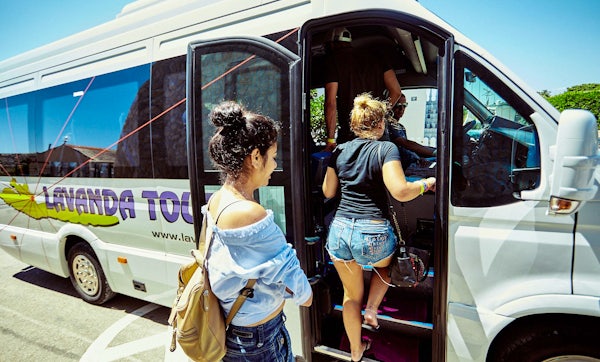
The most popular way to whiz over to Croatia to dip your toe in the bath-warm Adriatic has to be flying. Croatia used to suffer from a serious lack of inter-EU connections. Not anymore. There are loads of carriers offering direct hops into the land of pebble coves and rakija from all over – think London, Hamburg, Helsinki, Paris, and oodles more. Zagreb is still the largest airport, and where most long-haul flights arrive. It's not the best for island hoppers, though. We recommend trying to land at:
- Split Airport – A fantastic way to arrive into Croatia for island hopping. Not only is Split the main port for hitting Hvar, Brac and Vis (some of the best islands of all) but it's a downright awesome city by itself, with booming parties and a UNESCO core. There are loads of flight connections in the peak season, so you can get here from virtually anywhere in Europe.
- Dubrovnik Airport – Dubrovnik Airport is the third largest in Croatia as a whole. It's served by lots of flag carriers and also budget links on Jet2.com and easyJet. It's the best place to come to get to the stunning southern islands of Mljet and Korcula.
- Zadar Airport – Ryanair has recently added loads of routes to Zadar, a regional airport that's the best base for sailing adventures in the less-trodden northern Dalmatian region.

How to travel the Croatian islands
The Croatian islands stretch a whole 200 miles from the rugged rocks of the Kvarner Gulf in the north to the forested spots around Dubrovnik in the south. That's not quite the same spread as you get in Greece, but it's still a hefty distance. So, how to get between them? There are really only two ways…
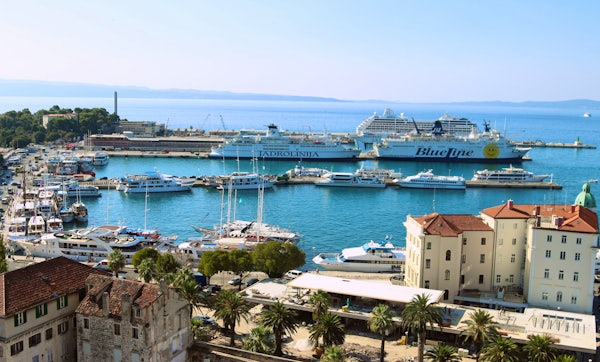
Virtually every single inhabited island in Croatia is served by at least one public ferry. They range from the big Jadrolinija car ferries to smaller island-to-island passenger ferries that are more like glorified fishing boats. We'd say they are by far the most convenient – and fun – way to travel from isle to isle (aside from having your very own yacht, of course).
Remember that lots of ferries run on a strict seasonal basis in Croatia. The peak season with the most services is between June and August. However, there are lots of ferries running as early as March and as late as October, too, but they are more subject to prevailing weather conditions.
Some towns are generally better for reaching different islands by ferry. For example:
- Split – for services to Hvar, Korcula, Brac, and Vis.
- Dubrovnik – for services to Mljet, Sipan, and Korcula.
- Zadar – For services into the Kvarner Gulf, and to Susak and Pula.
- Rijeka – Mainly for services into the Kvarner Gulf.
One thing that's worth knowing is that it's very rare for ferries to go from island to island directly. Yep, you might be able to see the pebble coves of your next destination across the strait but getting there will probably involve a trip to a port on the mainland and then a transfer to another boat. That's just the way it is in Croatia.
It is possible to hop seaplanes around the islands in Croatia but it's expensive. What's more, you'll miss the key experience of watching the Aleppo pines and the mountains drifting by as you travel by sea – the journey is very much part of the experience here.
What you can do is fly from town to town on the mainland in order to access different groups of islands during your Croatian odyssey. This works well if you, say, explore the Kvarner isles up north and then go from Pula to Dubrovnik to hit Mljet and the islands of southern Dalmatia.
Croatia island hopping itineraries
Some islands in Croatia naturally fit together to offer pre-made itinerary options. Remember that there's a mega 1,200 isles in this corner of Europe, so choosing just a few before you raise anchor and sail off is wise. Below are a couple of the most popular trips, however we recommend booking with the best in the business, Sail Croatia, for your Croatian Island Hopping adventure!
7-Day Croatia Island Explorer Route
Split – Brac – Hvar
A fantastic route for those seeking authentic Croatian experiences, this journey kicks off with the UNESCO wonders of Diocletian's Palace in Split - a spectacular starting point where towering Roman temples and Byzantine churches showcase Croatia's rich heritage. From there, the route takes you to Brač, where hiking to the island's highest peak reveals natural beauty that goes far beyond its famous beaches. Hvar caps off the experience perfectly - explore historic strongholds once used by Napoleon and Croatian pirates, then discover the UNESCO-listed Stari Grad Plain with its perfect blend of history and local culture. The stunning beauty of Krka National Park rounds out this incredible route that uncovers the authentic side of Croatia's islands and mainland treasures!
Island hopping from Dubrovnik
Dubrovnik – Mljet – Hvar
Dubrovnik is one of those bucket-list cities, with castles that featured in Game of Thrones and an old town that's simply irresistible. A boat from the port there will take you to Mljet, one of the wildest of the Adriatic islands, where pine woods cascade to shimmering lakes. A return to Dubrovnik is required for the leg up to Hvar, where you can either party in Hvar Town's buzzing bars or hike wildflower-fringed trails across the rugged backcountry.
Island hopping from Zadar
Zadar – Pag – Rab – Krk
This northern island-hopping route skips the most popular islands in favour of more off-the-beaten-track locations. The charming city of Zadar starts things off (don't miss the strange Sea Organ on the Riva promenade there), followed by rustic Pag and it's brown-paper hills and cheese farms. Rab is next – it's a beach lover's dream, what with cliff-backed coves in the north and rare sandy beaches on the gorgeous Lopar Peninsula. Krk is the final destination, offering a proper hit of R&R thanks to its abundance of lively coastal resorts that are uber-vibrant in the summer months.
The most beautiful coastal regions of Croatia
While in Greece you'll usually be going from island to island, here you'll often intersperse island visits with trips to the mainland. That adds a unique side to things because it means you get to check off Roman ruins and sleek riviera beaches on the way. Here are the main stomping grounds of island hoppers on the Croatian mainland…
North Dalmatia is the midriff of Croatia. Spreading across a coastal plain on the lowlands beneath the Dinaric Alps, it goes from Sibenik (a truly gorgeous town draped over a cypress-spotted hill) to Zadar up north. The area oozes Mediterranean charm, with olive farms occupying the dusty rural areas and a shoreline of pebbly beaches where sunbeds and tanning bodies are the order of the day between June and August.

Arguably the most famous travel region of them all, Central Dalmatia encompasses the ports of Trogir down to the yacht-speckled waters around Hvar. On the mainland, the beaches hit a zenith at the Makarska Riviera, a 37-mile run of mountain-backed coves that looks more Monte Carlo than Croatia at points. Central Dalmatia is especially fantastic for urban explorations. It's home to Split, which we'd say is the most immersive city in the country, what with palaces that date back to the age of Diocletian and more pumping beach bars than you can shake a shot of rakija at!
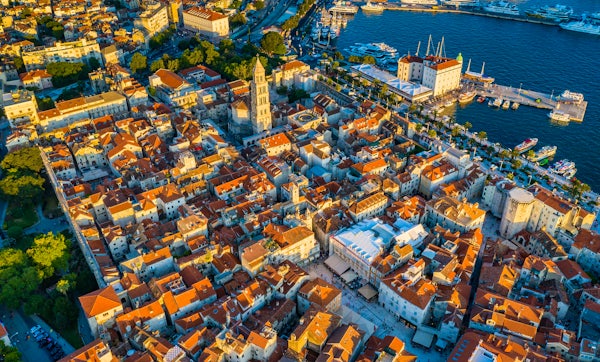
South Dalmatia is actually an exclave of Croatia, so you'll need to travel across a small coastal strip in Bosnia and Herzegovina to get there overland. Dubrovnik is its jewel in the crown. Head there to gawp at soaring 13th century city walls and behold the old citadel of Ragusa, one of the most stunning places in the Med. Elsewhere, the region hides sleepy fishing towns like Slano and Orašac but also has its fair share of glitzy coast hotels.

With the industrial port town of Rijeka at its heart, the Kvarner Gulf is probably the least touristic region of all. That shows, too, as the towns take on a distinctly local air and big motorways flank the coastline. It's a good region to consider if you want to hit the Franciscan monasteries and castles of Krk island, or join your island hopping with visits to Zagreb and the beer town of Karlovac further inland.

Jutting into the top of the Adriatic like a serrated arrowhead, Istria is the northern haunch of Croatia. It's heavily influenced by Italy, with towns like Motovun and Rovinj offering handsome marble churches next to konoba (taverns) that serve truffle tagliatelle and pizzas. If do you come here, do not miss Pula, where a colossal Roman amphitheatre is among the finest ancient ruins outside of Rome.

The 7 best Croatia islands to visit
With so many awesome places to choose from, it can be hard to pinpoint the Croatian islands that are best for your trip. Cue this list of seven, which we've put together using our years and years of expertise around this salt-washed land of pine trees and pebble coves. You're going to love em'!
Hvar is up there with Mykonos and Ibiza. It's one of the Med's undisputed good-time isles. There's loads of sun (it's the driest place in Croatia) and a town (Hvar Town) that, if it were a person, would be a designer-clad yachtie with a cocktail in one hand and glass of champagne in the other. During the summer, Hvar is a party mecca with sunset bars and rollicking DJ clubs that will take it to the limit. But there is another side to it if that's not quite your vibe. For that, venture over the mountains to Stari Grad, where moody squares and old churches abound.

Settled by both Greeks and Italians, Korcula is often likened to Corfu over the border. That's not a bad thing. It evokes a sense of sheer natural beauty that only undulating hills arrayed in pine woods from top to toe could manage. When the island hits the sea it becomes a yachter's dream, with all sorts of little snorkelling coves and nooks and crannies where you can escape all human contact. Later on, dock up at Korcula Town, a maze-like medieval centre on its own mini-island on the east coast.
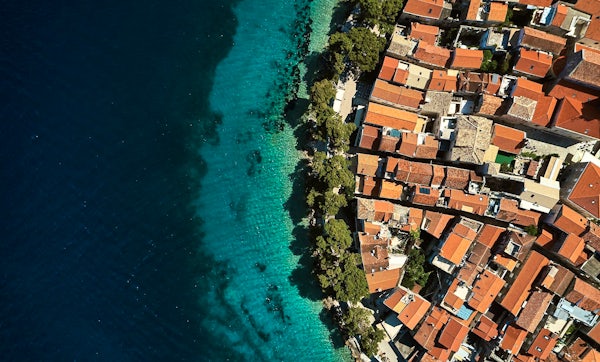
Brac is hard to ignore. It's a huge slab of land that sits neatly between Split and Makarska just off the Dalmatian coast. Often the first port of call for island hoppers, it's famed for the Golden Cape (the Zlatni Rat), a fantastically curvaceous beach of pure white pebbles that runs out 300 meters into the Adriatic. Don't just laze there, no matter how tempting it might be – the island also claims the highest point of the Adriatic Islands, mysterious karst caves steeped in myth, and even Roman-era quarries.
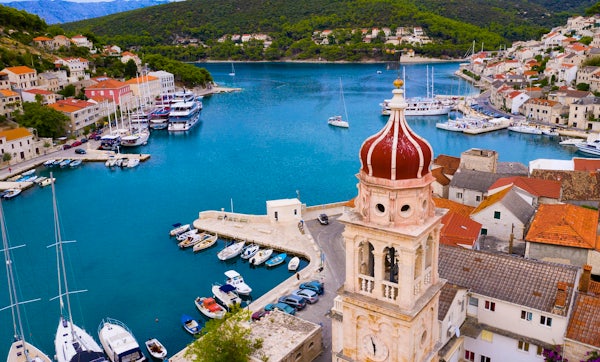
Krk is the northernmost and one of the largest of the Croatian islands. It's actually linked to the mainland by a direct bridge, which ensures it's also one of the most visited of the lot. There's loads of room to spread out and plenty of variety, though. Go south and you get a scorching climate that's balanced out by eye-watering bays like Oprna that look more Crete than Croatia. Up north, the coast is rugged and windblown, but there are quaint towns to hide away in – family friendly Omisalj, dramatic Vrbnik on its coastal perch.

Vis is like an island frozen in time. Once an out-at-sea naval base for the Yugoslav People's Army, it's littered with cave docks that look like something out of a 1990s James Bond film. Even the towns of little Komiza and Vis harbour retain an old-world essence. They're much more traditional, much more ramshackle than their compadres on the mainland. Choose this one if you're keen to get away from it all.

Nope, that's not Mars. That's Pag. A strange island of crumpled ridges and scrub hills, it looks positively lunar at points. The water is uber-clear because the geology is mainly rocky and there's not much sand to cloud up the shores, while the coastline is a haze of boulder-dotted beaches that hide beneath the white-tinged cliffs. Traditional cheeses and crafts are the order of the inland villages but there's also one place to party: Zrce Beach and it's colossal mega club.

Rab is only a stone's throw off the coast of the Kvarner region and it's a popular place for those who like a good balance between holiday amenities and adventure. The south-west coast is a built-up roadway of villas and small village centres. That clutches the bottom of a single ridge of mountains that protects the Lopar Peninsula in the north. You can head up there to discover some of the best beaches in the country. Seriously, just check out Sahara Beach or the honey-hued sands of Podsilo.

